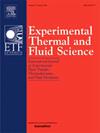液体燃料引爆中的液滴破裂和蒸发
IF 2.8
2区 工程技术
Q2 ENGINEERING, MECHANICAL
Experimental Thermal and Fluid Science
Pub Date : 2024-09-26
DOI:10.1016/j.expthermflusci.2024.111324
引用次数: 0
摘要
在以液体为燃料的爆炸中,液滴在重叠的时间和空间尺度上受到无数复杂的相互依存的物理现象的影响,导致快速汽化。同时发生的流体动力学破裂过程提高了液滴汽化的速度。本文介绍了在高韦伯数 O(104-105)的自持液体燃料爆燃中,利用激光光学米氏散射成像对小(d<125μm)液滴破裂进行成像的实验。实验的初始条件,包括液滴大小和质量分布,都得到了描述和报告。观察到液滴与爆轰波相互作用产生的子液滴云在爆轰前沿约 10 毫米处持续存在,宽度达到毫米量级。与等效气态爆轰的计算结果相比,多相爆轰波速的速度差为 10%。大量液滴的存活距离和破裂云的形态与相关蒸发和破裂模型的预测结果进行了比较。计算结果表明,仅蒸发就会导致液滴存留距离比观测到的距离长几个数量级。在蒸发的同时,液滴会在较长的时间内发生破裂,这一过程提供了一种现象学解释。与基于线性稳定性理论的理论模型相比,为冲击驱动破裂建立的经验模型预测了更大的子液滴尺寸,得出的存活距离和云形状在实验所见的数值范围内。然而,观察到的液滴持续时间比两种模型预测的都要长。计算结果和实验结果之间的差异表明,有必要开发适合于受可变加速度影响的液滴的模型,以充分解释多相起爆。本文章由计算机程序翻译,如有差异,请以英文原文为准。
Droplet breakup and evaporation in liquid-fueled detonations
In liquid-fueled detonations droplets are subjected to a myriad of complex codependent physical phenomena occurring on overlapping temporal and spatial scales, resulting in rapid vaporization. The rate at which droplets vaporize is enhanced by the concurrent hydrodynamic breakup processes. This article describes experiments where small () droplet breakup at high Weber number is imaged in a self-sustained liquid-fueled detonation with laser optical Mie scattering imagery. Experimental initial conditions, including the droplet size and mass distribution, are characterized and reported. Child droplet clouds generated from droplet interactions with detonation waves are observed to persist for approximately 10 mm past the detonation front and grow to the order of millimeters in width. A velocity deficit of was observed for the multiphase detonations wave speed when compared to calculations for the equivalent gaseous detonations. The bulk droplet survival distances and breakup cloud morphology are compared to the predictions of relevant evaporation and breakup models. Calculations indicate that evaporation alone would result in droplet survival distances orders of magnitude longer than those observed. A droplet process whereby breakup occurs over an extended time, concurrent with evaporation, provides a phenomenological explanation. Empirical models constructed for shock-driven breakup predicted larger child droplet sizes than theoretical models based on linear stability theory, yielding survival distances and cloud shapes within the range of values seen in experiments. Droplets were however observed to persist longer than either model would predict. The discrepancy between calculations and experiment indicate that development of models tailored to droplets subject to variable acceleration are necessary to fully explain the multiphase detonation.
求助全文
通过发布文献求助,成功后即可免费获取论文全文。
去求助
来源期刊

Experimental Thermal and Fluid Science
工程技术-工程:机械
CiteScore
6.70
自引率
3.10%
发文量
159
审稿时长
34 days
期刊介绍:
Experimental Thermal and Fluid Science provides a forum for research emphasizing experimental work that enhances fundamental understanding of heat transfer, thermodynamics, and fluid mechanics. In addition to the principal areas of research, the journal covers research results in related fields, including combined heat and mass transfer, flows with phase transition, micro- and nano-scale systems, multiphase flow, combustion, radiative transfer, porous media, cryogenics, turbulence, and novel experimental techniques.
 求助内容:
求助内容: 应助结果提醒方式:
应助结果提醒方式:


